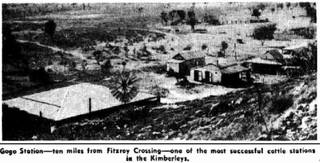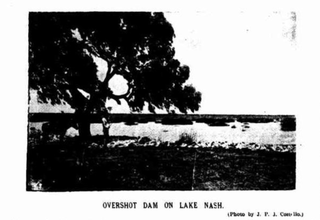Auvergne Station, often just referred to as Auvergne, is a pastoral lease that operates as a cattle station in the Northern Territory of Australia.
Auvergne Station, often just referred to as Auvergne, is a pastoral lease that operates as a cattle station in the Northern Territory of Australia.
It is located about 50 kilometres (31 mi) west of Timber Creek and 137 kilometres (85 mi) east of Kununurra, in the Northern Territory but close to the border of Western Australia. Auvergne shares a boundary with Bullo River Station to the north, Newry to the west and the Winan Aboriginal Land Trust to the south. The Victoria Highway and the Auvegne Stock Route both bisect the property from east to west. [1]
Occupying an area of 4,142 square kilometres (1,599 sq mi) of which about half is forested country, a quarter of which is open plains well covered in mitchell and flinders grasses. The last quarter is made up of red loam river country and coastal flood plains. [2] The property is capable of carrying 32,000 head of stock and annually turns off 10,000 head to markets in Asia via the port of Wyndham in Western Australia. The property is currently operated by Clean Agriculture and International Tourism. [3]
Several watercourses run through the property including the Bullo River, Baines River, East Baines River, Blackfellow Creek and Snake Creek with the Victoria River forming the northern boundary. [1]
Auvergne was established in 1886. [2] The initial owner was John Arthur Macartney, [4] who had 2,000 cattle overlanded to Auvergne in 1886 with another 8,000 on the road behind them. [5] Sam "Greenhide" Croker was one of the first station managers at Auvergne. He was shot dead in 1892 during a game of cards by an Aboriginal stockman named Charley Flannigan. Flannigan was arrested at Ord River Station and escorted to Darwin for trial, [6] where he was found guilty and duly executed in 1893. [7] Flannigan was the first person legally executed in the Northern Territory. [8]
The notorious Jack Watson took over management at Auvergne after the death of Croker but only lasted a year, resigning in 1894. [9]
The property was acquired by Francis Connor and Denis Doherty in 1896, by this stage the station occupied an area of 2,000 square miles (5,180 km2) with frontage onto the Victoria River. It was stocked with approximately 7,000 head of cattle and 300 horses and was to be managed by Mr Desmond. [10] By 1897 Michael Durack became a part-owner of the station. [11]
Flanagan was arrested at Ord River Station and escorted to Darwin for trial. [12] Flanagan was tried, found guilty and duly executed in 1893. [13]
By 1905 the size of the station was estimated at 1,640 square miles (4,248 km2) and had a herd of approximately 20,000 shorthorn cattle said at the time to be "in splendid condition". The recent seasons had been good and the Baynes River East and Baynes River east were both flowing with the billabongs and lakes all full of water. [14]
A stockman named Alexander McDonald was murdered by Aboriginal people at Auvergne in 1918, [15] he was found by the station manager, Archie Skulthorp, with a spear in his back and the "tracks of a big mob of natives" leading off into the bush. [16]
By 1923 the size of the property was estimated at 5,900 square miles (15,281 km2) and it was one of the larger runs in the Northern Territory, although it was less than half the size of the largest of the day, Victoria River Downs, which occupied 13,100 square miles (33,929 km2). [17]
An Aboriginal murderer known as "Tiger" was murdered himself at Auvergne in 1953. Tiger was killed by another Aborigine man known as "Split Lip Dick", who fled into the bush with Tiger's young wife. [18] Over 5,000 unbranded scrub bulls had to be shot at the property in the same year. Most of were thought to have come from neighbouring Victoria River Downs, which was a far less developed property. Auvergne had a herd of about 18,000 head in 1953. [19] At about the same time the property had been acquired by the Peel River Land and Mineral Company along with Headingly Station in Queensland. [20]
In 2010 the station manager, Stuart McKechnie, found the fossilised remains of a diprotodon sticking out of a riverbank on the property. Although lacking a tail and a head, the skeleton was almost completely intact. McKechnie kept the remains a secret for two years before palaeontologists from the Museum and Art Gallery of the Northern Territory came to excavate it in 2012. [21]

The Northern Territory is an Australian territory in the central and central northern regions of Australia. The Northern Territory shares its borders with Western Australia to the west, South Australia to the south, and Queensland to the east. To the north, the territory looks out to the Timor Sea, the Arafura Sea and the Gulf of Carpentaria, including Western New Guinea and other islands of the Indonesian archipelago.

Nathaniel Buchanan was an Australian pioneer pastoralist, drover and explorer.

Argyle Downs is a pastoral lease and cattle station located about 120 kilometres (75 mi) south east of Kununurra in the Kimberley region near the border of Western Australia and Northern Territory. It is operated by the Consolidated Pastoral Company.
Balfour Downs Station is a pastoral lease and cattle station located approximately 132 kilometres (82 mi) northeast of Newman, 88 kilometres (55 mi) east of Roy Hill and 108 kilometres (67 mi) southeast of Nullagine in the Pilbara region of Western Australia. At 6,395 square kilometres (2,469 sq mi), it is among the largest cattle stations in Australia.

Gogo or Gogo Station and sometimes referred to as Margaret Downs is a pastoral lease that has operated as a cattle station. It is located about 11 kilometres (7 mi) south of Fitzroy Crossing and 83 kilometres (52 mi) north east of Yungngora in the Kimberley region of Western Australia.
Jimmy Pike (c1940-2002) was a Walmatjarri Aboriginal artist.

Alexandria Station is a pastoral lease that operates as a cattle station and is the Northern Territory's largest pastoral property and Australia's third largest pastoral property after Anna Creek station and Clifton Hills Station.
Victoria River Downs Station, also known as Victoria Downs and in the past sometimes referred to as The Big Run, is a pastoral lease that operates as a cattle station in the Northern Territory of Australia, established in 1883.

Brunette Downs Station, mostly referred to as Brunette Downs, is a pastoral lease operating as a cattle station in the Northern Territory of Australia.

Wave Hill Station, most commonly referred to as Wave Hill, is a pastoral lease in the Northern Territory operating as a cattle station. The property is best known as the scene of the Wave Hill walk-off, a strike by Indigenous Australian workers for better pay and conditions, which in turn was an important influence on Aboriginal land rights in Australia.
Walhallow Station also once known as Walhallow Downs often just referred to as Walhallow is a pastoral lease that operates as a cattle station in the Northern Territory of Australia.

Lake Nash Station, most commonly known as Lake Nash, is a cattle station on the Barkly Tableland in the Northern Territory, Australia.
Joseph Bradshaw was a pastoralist in Western Australia and then the Northern Territory.

Bradshaw Station, most commonly known as Bradshaw's Run, was a pastoral lease that operated as a cattle station in the Northern Territory of Australia.
Bedford Downs, or Bedford Downs Station, is a pastoral lease that operates as a cattle station in Western Australia.
Kimberley Downs Station, commonly referred to as Kimberley Downs, is a pastoral lease that operates as a cattle station in Western Australia.

John Arthur Macartney was an Irish-born Australian colonist, pastoralist, squatter and grazier who established a large number of frontier cattle stations in Queensland and the Northern Territory.

John Watson was a frontier cattle station manager, drover, and murderer in the British colony of Queensland and in the Northern Territory. He was renowned for his fearless behaviour and also his sadistic brutality toward Indigenous Australians. He was called "The Gulf Hero" due to much of his fame being achieved while working on pastoral properties located in the Gulf Country.
Charlie Flannigan was an Aboriginal Australian stockman from the then colony of Queensland who was the first person to be executed in the Northern Territory in 1893.